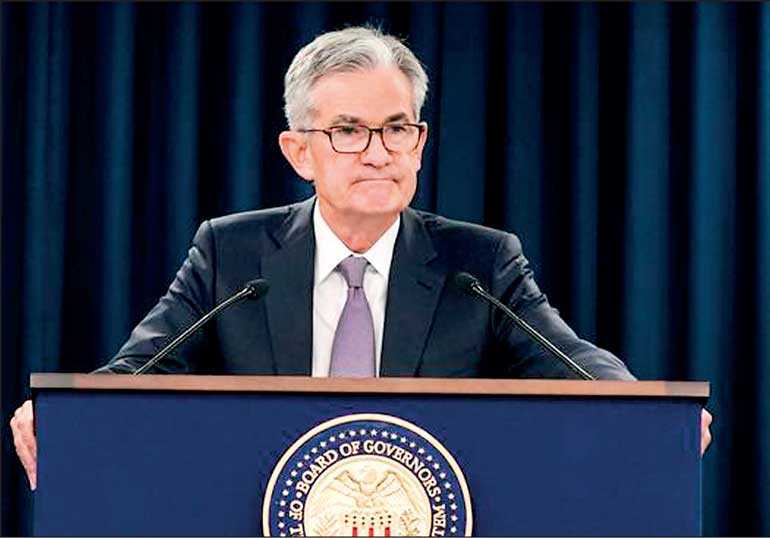Monday Apr 21, 2025
Monday Apr 21, 2025
Friday, 20 September 2019 00:00 - - {{hitsCtrl.values.hits}}

WASHINGTON (Reuters): The US Federal Reserve cut interest rates again on Wednesday to help sustain a record-long economic expansion but signalled a higher bar to further reductions in borrowing costs, eliciting a fast and sharp rebuke from President Donald Trump.
Describing the US economic outlook as “favourable,” Fed Chair Jerome Powell said the rate cut was designed “to provide insurance against ongoing risks” including weak global growth and resurgent trade tensions.
“If the economy does turn down, then a more extensive sequence of rate cuts could be appropriate,” Powell said in a news conference after the Fed announced it had lowered its benchmark overnight lending rate by a quarter of a percentage point to a range of 1.75% to 2.00%. It was the second Fed rate cut this year.
But, Powell said, “what we think we are facing here is a situation which can be addressed, which should be addressed, with moderate adjustments to the federal funds rate,” noting that the US labour market was strong and inflation was likely to return to the Fed’s 2% annual goal.
“We are going to be highly data-dependent ... We are not on a pre-set course, we are going to be making decisions meeting by meeting,” Powell said, adding that the Fed would stop cutting rates “when we think we’ve done enough.”
Trump blasted Powell, saying the central bank chief had “No ‘guts,’ no sense, no vision!” “A terrible communicator,” Trump tweeted before Powell had even begun his news conference.
Later, Trump told reporters during a trip to California: “I think it’s fine. I think that frankly they should have acted faster.”
Underscoring divisions within the central bank, the quarter-point rate cut on Wednesday drew dissents from three of the 10 voting policymakers.
Kansas City Fed President Esther George and Boston Fed President Eric Rosengren called for no rate cut, and St. Louis Fed President James Bullard wanted a bigger half-point rate cut.
Forecasts from all 17 policymakers released at the end of the meeting showed even broader disagreement, with seven expecting a third rate cut this year, five seeing the current rate cut as the last for 2019, and five who appeared to have been against even Wednesday’s move.
The central bank also widened the gap between the interest it pays banks on excess reserves and the top of its policy rate range, a step taken to smooth out problems in money markets that prompted a market intervention by the New York Fed this week.
In a hint that the Fed may soon take bigger steps, Powell acknowledged that strains in funding markets had been bigger than expected, and he said the central bank may need to resume increases to the Fed’s balance sheet “earlier” than previously thought.
Discover Kapruka, the leading online shopping platform in Sri Lanka, where you can conveniently send Gifts and Flowers to your loved ones for any event including Valentine ’s Day. Explore a wide range of popular Shopping Categories on Kapruka, including Toys, Groceries, Electronics, Birthday Cakes, Fruits, Chocolates, Flower Bouquets, Clothing, Watches, Lingerie, Gift Sets and Jewellery. Also if you’re interested in selling with Kapruka, Partner Central by Kapruka is the best solution to start with. Moreover, through Kapruka Global Shop, you can also enjoy the convenience of purchasing products from renowned platforms like Amazon and eBay and have them delivered to Sri Lanka.
Discover Kapruka, the leading online shopping platform in Sri Lanka, where you can conveniently send Gifts and Flowers to your loved ones for any event including Valentine ’s Day. Explore a wide range of popular Shopping Categories on Kapruka, including Toys, Groceries, Electronics, Birthday Cakes, Fruits, Chocolates, Flower Bouquets, Clothing, Watches, Lingerie, Gift Sets and Jewellery. Also if you’re interested in selling with Kapruka, Partner Central by Kapruka is the best solution to start with. Moreover, through Kapruka Global Shop, you can also enjoy the convenience of purchasing products from renowned platforms like Amazon and eBay and have them delivered to Sri Lanka.